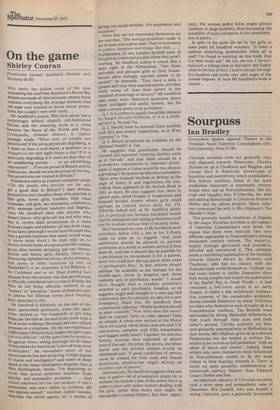Sourpuss
Ian Bradley
Everywhere Spoken Against: Dissent in tireVictorian Novel Valentine Cunningham (Oxford University Press £7.50)
Victorian novelists were not generally very well disposed towards Dissenters. Charles Dickens set up in Chadband and Stiggins, and George Eliot in Bulstrode, stereotypes of hypocrisy and insensitivity which established a firm literary tradition. Some of the most unpleasant characters in nineteenth century fiction were cast as Nonconformists, like the cruel and haughty Alec d'Urbeville, the wild and canting Barraclough in Charlotte Bronte's Shirley and the odious prophet 'Black John' who tyrannised his wife in Mrs Oliphant's The Minister's Wife.
This generally hostile treatment of Dissent by the major Victorian novelists is the subject of Valentine Cunningham's new book. He argues that there were basically two very different approaches to Nonconformity among nineteenth century writers. The majority, largely through ignorance and prejudice, ridiculed and caricatured it. This certainly seems a convincing explanation of the hostility towards Dissent shown by Dickens and Thackeray, who had no contact with the Nonconformist world themselves. Trollope too had every reason to dislike Dissenters since their moral scruples had halted the publication of his Rachel Ray in Good Words it had contained a ball-room scene in an early chapter. It seems a less satisfactory explanation, however, of the considerable antipathy shown towards Dissenters by many Victorian. novelists who themselves were brought up in a Nonconformist tradition. The BronOs were surrounded by strong Methodist influences in their youth through their aunt and their father's servant, Tabitha Aykroyd, yet they were generally unsympathetic to Methodists in their novels. Mrs Oliphant grew up as a devout Presbyterian but she tended to portray Dissenters in her novels as dull philistines "with an odour of bacon and cheese". Indeed, those writers who were themselves most influenced by Nonconformity tended to be the most violent in their hostility towards it. There is surely no more powerful condemnation of nineteenth century Dissent than Edmund Gosse's Father and Son.
An important minority of Victorian novelists took a more open and sympathetic view of Dissenters. Mrs Gaskell, who was herself a strong Unitarian, gave a generally favourable picture of Nonconformists in her novels although she also tended to perpetrate the
stereotype of the hard-faced dissenting factory owner. George Eliot, who like the Brontes had come under evangelical influences in her youth, displayed a strong admiration and sympathy for Dissenters, most notably in her portrayal of Dinah Morris in Adam Bede. Her views admittedly changed as her own humanist philosophy developed and in Felix Holt it was Holt, the secular radical politician, who effected the conversion of Esther, the heroine.
The most sympathetic of all Victorian novelists to the world of Dissent was undoubtedly William Hale White, the much underrated author of The Biography of Mark Rutherford and Revolution In Tanner's Lane. Hale White himself trained for the Independent ministry but undertook that journey through Unitarianism to rationalism which was made by so many in the mid-nineteenth century. Revolution in Tanner's Lane, published in 1887, chronicles the decline of militant Nonconformity in Britain and its transformation into secular radicalism and obscurantist theology. It has often been taken as an epitaph for the great Dissenting tradition established by Cromwell and Bunyan but, as Dr Cunningham rightly points out, it appeared at a time when the Nonconformist conscience was in many ways at its most powerful and was still to exercise considerable power on both politics and society.
There is a tendency in this book to avoid coming to any very definite conclusions and a certain circumspection in its argument. This is a pity — for there is much interesting material in the book both for readers of the Victorian novel and for those interested in nineteenth century social history. It would have been even more interesting, though, had Dr Cunningham been slightly less rigidly academic in his approach and concentrated more on the broader themes which are raised by his subject.
There are surely two very simple explanations why the picture of Dissent given in most Victorian novels is such an unsympathetic one. The first is that many writers in the nineteenth century really felt that the power of evangelical religion was essentially evil. The list of those sensitive Victorians who were profoundly disturbed by the terror and oppressiveness of the religious environment in which they were brought up is a formidable one: it includes Samuel Butler and John Ruskin as well as George Eliot, the Brontës and Edmund Gosse. Those Victorians who encountered the power of evangelical religion at first hand tended either to accept it wholeheartedly, or to react violently against it. The former, disapproving strongly of all fiction, could hardly be expected to write novels in its praise so it is not surprising that the bias of Victorian literature appears to be strongly against Dissent and evangelical Anglicanism.
The other reason why Dissenters fared so badly at the hands of Victorian novelists is simpler still. They were supremely easy to caricature. Where could nineteenth century novelists find more colour or oddity than in the real life world of Nonconformity where dwelt such characters as Henry Higginson, the roving ranter of Bilston who leapt through the floor of his Primitive Methodist Chapel, or Elijah Cadman, who kicked down the front panel of a pulpit in Grandborough to illustrate Jesus' final kick at the Devil? In cataloguing the wild exploits of these men in this comprehensive survey of nineteenth century Dissent, Valentine Cunningham answers the question he sets himself in his book.



































 Previous page
Previous page